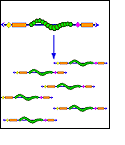|
 Previous Event | Next Event Previous Event | Next Event 
1987: YACs Developed
 Yeast artificial chromosomes (YAC) can carry large segments of DNA from other species, like humans. Yeast artificial chromosomes (YAC) can carry large segments of DNA from other species, like humans.
A YAC is copied reliably when a yeast cell divides. Plasmids – pieces of DNA in bacteria that can carry foreign DNA – and viruses are also used in the lab to store and copy fragments of human DNA. But YACs can carry million base-pair-long fragments of human DNA, whereas plasmids and viruses carry a few thousand base-pair-long pieces only. Being able to deal with bigger fragments of DNA made mapping the human genome easier, especially when scientists still had relatively few landmarks to navigate by.
 Previous Event | Next Event Previous Event | Next Event 
Last Reviewed: April 17, 2008
|

